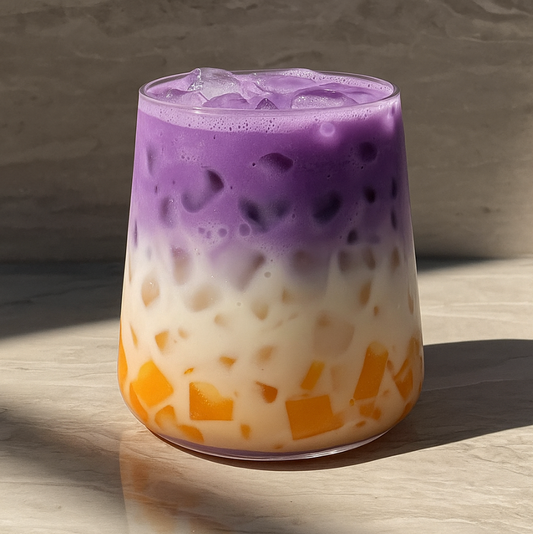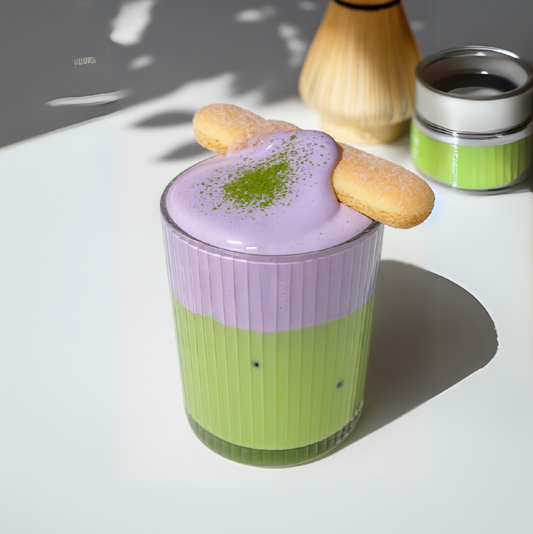Ube vs Purple Sweet Potato: real differences (flavor, texture, nutrition, cooking)
People often confuse ube (purple yam, Dioscorea alata) with the purple sweet potato (Ipomoea batatas). Both are colorful tubers, but they are different plants with different culinary uses. This guide clarifies the differences so you can choose the right one—whether for dessert, a savory gratin, a creamy velouté or a curry with coconut milk.
You may also like: Ube vs Taro – What’s the difference?

🌱 Botany & origins
Ube is a tropical climbing yam grown across Southeast Asia; its elongated tuber has a deeply pigmented purple flesh. The purple sweet potato is a variety of sweet potato (vegetable root, family Convolvulaceae) cultivated in South America and the Caribbean. Bottom line: yam ≠ sweet potato; two distinct tubers.
🎨 Color, texture, cooking
- Color: ube stays deep purple after cooking; sweet potato ranges from lilac to dark purple, sometimes with white flesh marbling.
- Texture: ube is highly starchy and becomes silky once blended; purple sweet potato is more fibrous, great roasted in cubes or mashed with a potato ricer.
- Cooking: for ube purée/powder, simmer gently in a saucepan with a little stock. For sweet potato, steam or boil in salted water, then peel and mash.
👅 Flavor
Ube tastes delicately sweet with notes of hazelnut/chestnut—perfect for creams, custards, ice creams and violet lattes. Purple sweet potato is sweeter and earthier—ideal for savory dishes: Parmentier-style gratin, curry with coconut milk and spinach, or skillet sides with onion, garlic, pepper, nutmeg and coriander.
🍽️ Quick comparison table
| Ube (purple yam) | Purple sweet potato | |
|---|---|---|
| Botany | Yams (Dioscorea) | Convolvulaceae (Ipomoea batatas) |
| Texture | Dense, very starchy; silky purées/veloutés | More fibrous; holds in cubes |
| Flavor | Nutty, mild, sweet | Sweet, earthy |
| Best uses | Desserts, lattes, spreads, creams | Mash, gratin, curry, fries |
| Color | Stable deep purple | Lilac to dark purple, sometimes white-fleshed marbling |
🔬 Nutrition
Both tubers provide fiber, complex carbs and key minerals. Ube stands out for anthocyanins and vitamin C; purple sweet potato adds beta-carotene (pro-vitamin A). Keep the glycemic index moderate with gentle cooking and minimal added sugar.
👩🍳 Prep & cooking
For silky ube purée, boil cubes in salted water, drain, push through a ricer and blend with a little crème fraîche or coconut milk. For a gratin, layer slices of sweet potato with reduced stock, garlic and onion, then bake until golden.
For curry, sauté aromatics in a saucepan, add cubes, a splash of stock, finish with coconut milk.
🍰 Sweet side
Ube shines in desserts—muffins, panna cotta, creams, marbled cheesecake—and in drinks like violet lattes and hot chocolate.
🥗 Savory ideas (purple sweet potato)
- Velouté with onion, carrot, curry, crème fraîche.
- Parmentier with a lentil base.
- Rösti—grated sweet potato, egg, herbs.
- Warm salad—roasted slices, crunchy cabbage, peas.
🛒 Buying & storage
Choose firm tubers; store cool and dry (not refrigerated unless cooked). Avoid overcooking and artificial dyes.
✅ Summary
For antioxidant purple desserts: choose ube. For structured savory mains: pick purple sweet potato. Combine both for the best of each.
Get it now to make delicious recipes: lattes, cakes, bread…












